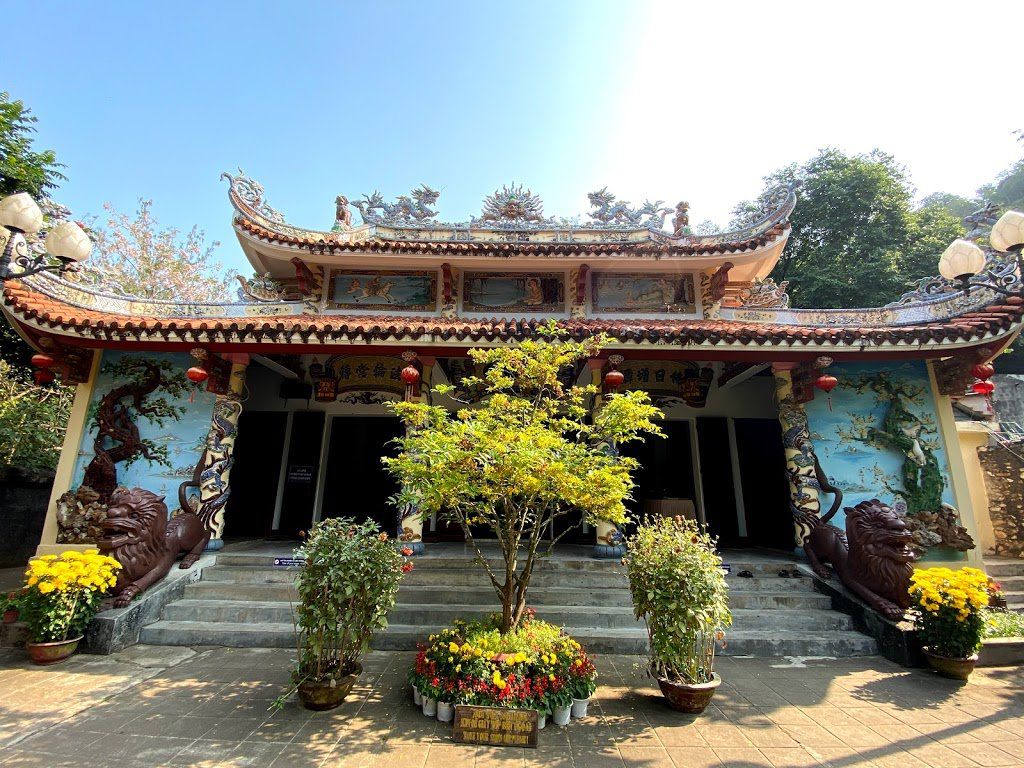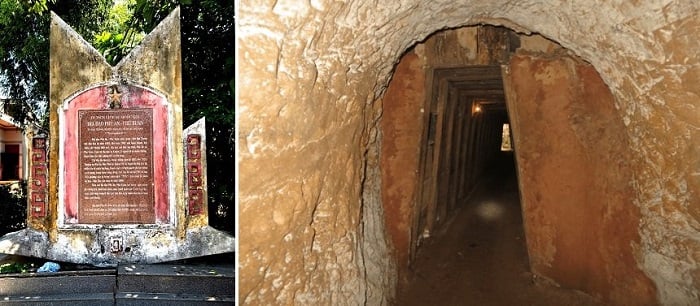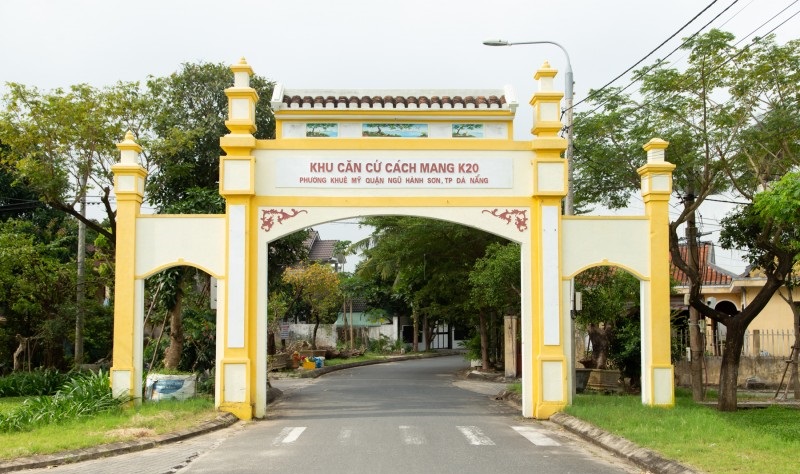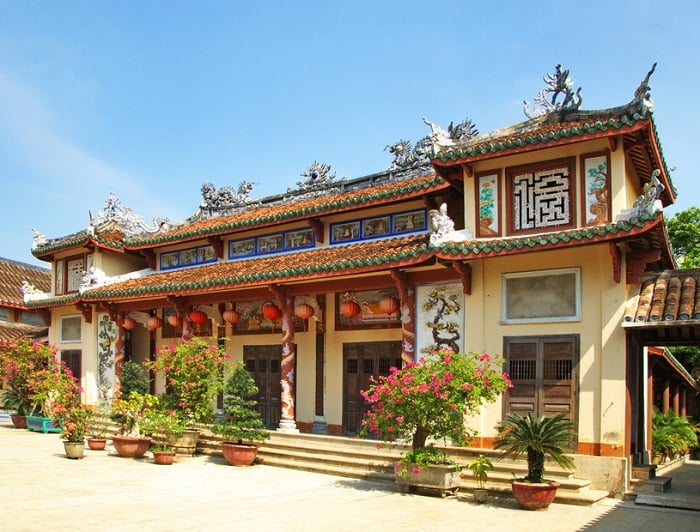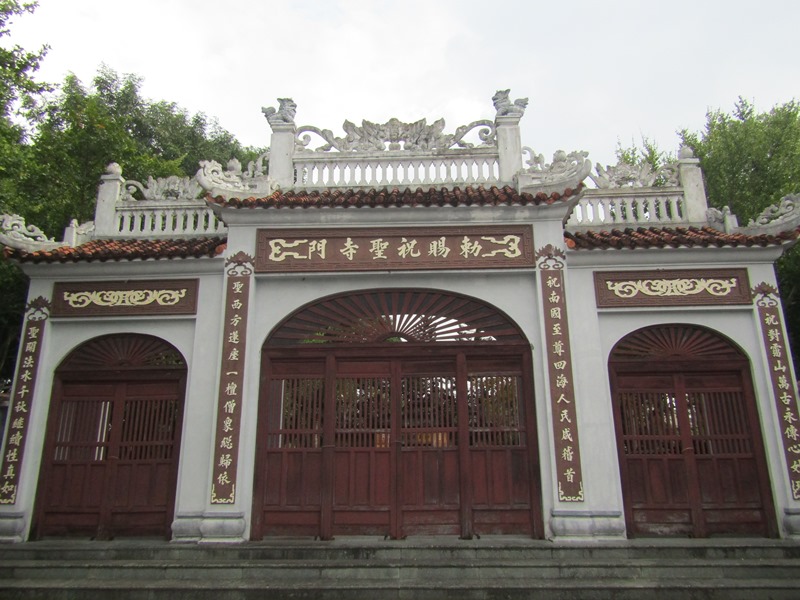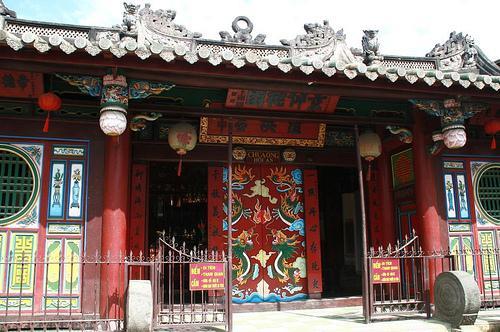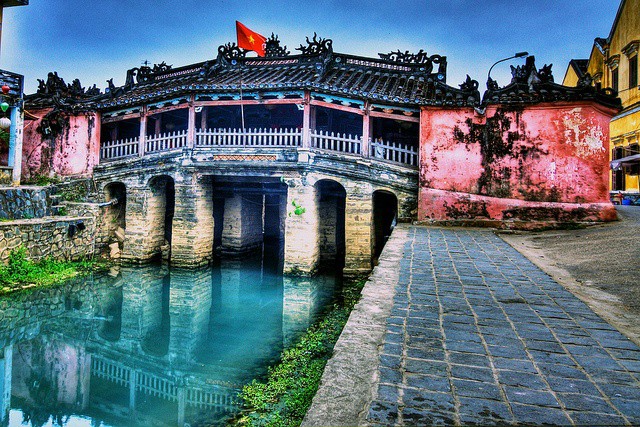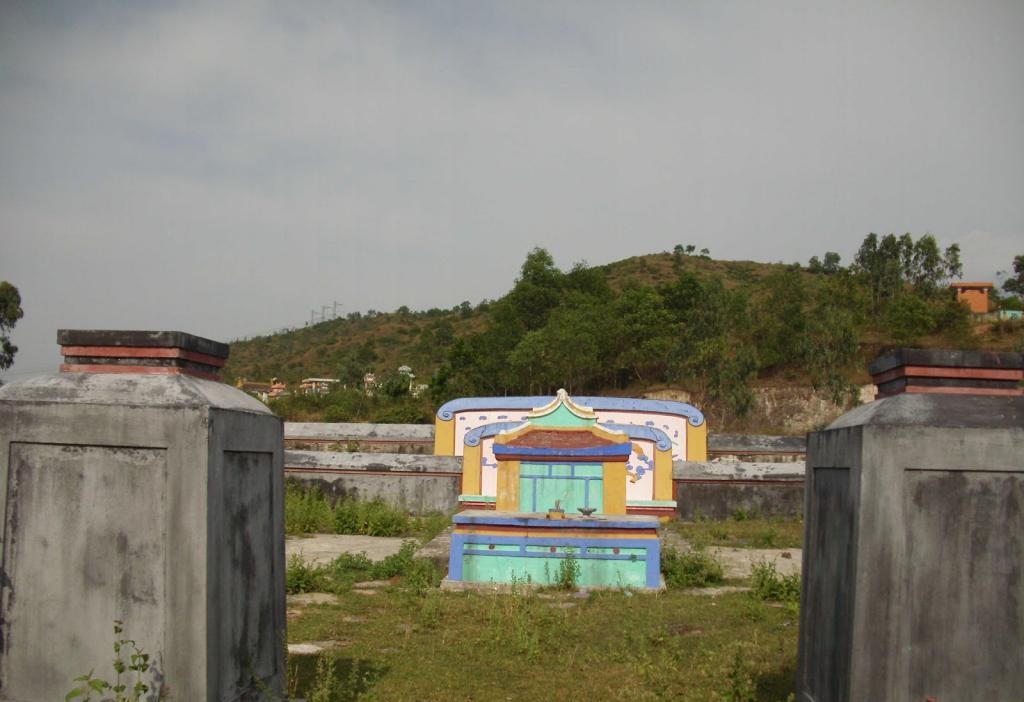Relic point Vietnam
Việt NamNational Temple of Tam Thai
Located in the Ngu Hanh Son scenic complex, on Thuy Son mountain, Tam Thai Pagoda is the oldest pagoda in Da Nang city. Tam Thai Pagoda was first built in 1630 with the literal name Tam Thai Tu. By the Tay Son period, the pagoda was completely damaged. In 1825, during the reign of King Minh Mang, the pagoda was rebuilt and under the Nguyen Dynasty, the pagoda was decreed to be a National Tu. The appearance of the pagoda today has changed compared to the original because it has undergone many restorations between 1907 and 1995. Currently, the pagoda still retains the Tam Thai Tu sign and the The heart-shaped golden tablet is engraved according to the pen of King Minh Mang with the content praising the Buddha Dharma for its immeasurable compassion and universal compassion for all sentient beings... Because of its beautiful and ancient architecture and located in the Ngu Hanh Son scenic complex, Tam Thai Pagoda attracts many tourists every day to worship and offer incense. From the foot of Thuy Son mountain, visitors follow the time-printed stairs to reach Tam Thai. The pagoda has 3 floors: The first floor in the north is called Thuong Thai. The second floor to the south is called Trung Thai. The third floor to the east is called Ha Thai. The architecture of Tam Thai Pagoda has Tam Quan gate, main pagoda, ancestral temple corridor area and other works of art. In front of Tam Thai Pagoda is a large yard with tall trees spreading shade throughout the yard. The Tam Quan gate is made in the style of a roofed bell tower and looks very ancient. When passing through the Tam Quan gate and reaching the inner courtyard, the Maitreya Buddha statue will be the first image visitors see. The statue is carved from sandstone and is quite large in size. On both sides of the yard are palaces, which King Minh Mang built as a place to rest when visiting the pagoda. The main pagoda is located behind this courtyard. The pagoda is built of bricks, facing south. The roof is tiled with glass, the roof is decorated with two dragons flanking the moon, and the columns are decorated with dragons and phoenixes. On both sides of the front wall are reliefs of Ta Phu and Huu Bat - two deities guarding the pagoda. The main hall of the pagoda worships Amitabha Buddha, Bodhisattva Avalokiteshvara and Mahasthamaprapta. In general, the overall architectural landscape of the pagoda is built in the shape of the letter Vuong with many highly aesthetic lines. According to historians and architects, Tam Thai pagoda is typical of pagoda architecture during the Nguyen Dynasty. Besides the main works, Tam Thai pagoda also has Vong Giang tower, also known as Vong Giang Dai. This is the highest point on Thuy Son mountain. If you stand from here, visitors can see a vast area, covering the majestic scenery of Ngu Hanh Son, in the distance are the surrounding Han and Cam Le rivers. co. Although the current pagoda architecture has the typical architectural style of the Nguyen Dynasty because it has been repaired many times, Tam Thai Tu is still considered an ancient pagoda in Da Nang because this spiritual project has been constructed. Built in 1630. With great historical value, Tam Thai Pagoda has been recognized as a national historical-cultural relic. Source: To Quoc Electronic Newspaper
Da Nang 3779 view
Phu An - Phu Xuan Tunnels
Phu An - Phu Xuan Tunnels were constructed from 1965 to 1966, while the American enemy massively sent troops into the South of our country, waging a local war. The enemy encouraged people to enter the corner area, aiming to isolate and separate our army and people. With a length of 850 meters, connecting the two villages of Phu An and Phu Xuan in Dai Thang commune, located right at the armpit of the My - Pup camp but surrounded on three sides by the Thu Bon and Vu Gia rivers, there are also village bamboo ramparts. shelter. Under the direction of the Quang Da Special Region Party Committee and the determination of the army and people of Dai Loc region B, every night, mothers, fathers, children, guerrilla soldiers... always take turns keeping watch. The enemy's aircraft and heavy artillery just crept into every corner of the dug tunnel, carrying baskets of soil to form the tunnels: Phu An - Phu Xuan tunnel has a strategic stature: it is one of the forward bases of the Quang Da Special Region Party Committee. This place continuously receives large sources of officers and main troops from the rear to supplement the battlefield; workplace and meeting place of the Quang Da Special Region Party Committee, Region V Party Committee, of Front 44 from 1965 to 1972. This is also a safe place for comrades: Vo Chi Cong - former Secretary Regional Party Committee of Region V, General Chu Huy Man - former Deputy Secretary - Commander of Military Region V, General Doan Khue - former Deputy Political Commissar of Region V, Lieutenant General Nguyen Chanh - Commander of Front 44 Quang Da, Former Admiral Navy Giap Van Cuong - former Standing Committee of the Special Zone Party Committee - Deputy Commander - Chief of Staff of Front 44 and many other leaders and generals who fought and worked in the Quang Da battlefield were also present on the land. Phu An. Comrade Pham Duc Nam, former Chairman of the Revolutionary People's Committee, Chairman of the Forward Council of Quang Da province at that time commented: Phu An - Phu Xuan Tunnels is "a great contribution of the Dai people". Victory for the entire province's cause. Now, when I remember, I am still grateful to the people, the guerrillas, the Party Committee, the survivors, and those who fell in this heroic land." Phu An - Phu Xuan Tunnels are also a place for guerrillas, commune and village officials to stay and fight the enemy; is where the forward command post was located in battles when our troops attacked the enemy at An Hoa and Duc Duc bases. With the scale of the project and the achievements left behind, Phu An - Phu Xuan Tunnels will forever exist as a glorious victory in the history of the nation's revolutionary struggle, and the pride of the people of Dai Loc. The country has entered the phase of construction and development. It is also necessary to restore historical relics and educate traditions for present and future generations to remember the victories and sacrifices of their fathers. Remembering the past, we make today's life more beautiful. Source: Electronic Information Portal of Dai Loc District People's Committee
Da Nang 3221 view
K20 Revolutionary Base Area
The K20 revolutionary base is considered a symbol of the resilient and indomitable revolutionary spirit of the people of Da Nang in general and of Ngu Hanh Son district in particular during the resistance war against the US to save the country. The name K20 - is the code name to refer to the Da Man revolutionary base, where the District III Party Committee and the Da Nang City Party Committee are stationed to lead the revolutionary movement. In 1965, the situation in Da Man and Bac My An in particular, and Da Nang city in general, was extremely complicated. The US began sending troops into the South, implementing the "Local War" strategy, building many large military bases in the South, including Da Nang. The US goal is to build Da Nang into a military base that combines the Navy, Army, and Air Force in a solid, long-term manner, located in the North; protect the capital of the puppet puppet regime in the South, so the US built more bridges across the Han River, built a helipad in Nuoc Man, expanded and strengthened Da Nang airport and sent 17 orders. The American and Wei Dynasty arrived in Da Nang. For the US, this is a very important place, with facilities concentrated for the war in the Central region. As for us, the K20 revolutionary base is located in Da Man 5 residential area, Khue My ward, Ngu Hanh Son district, about 10 km southeast of Da Nang city; The Northeast borders the sea, the West is the Han River, the South is sunken fields and the Vinh Dien River; At the same time, it is adjacent to Hoa Vang district and Da Nang city, and is a gateway to block and protect the city from the Southeast. After the Geneva Accords, the United States and Ngo Dinh Diem's lackey government built many posts around Da Man Base to form a closed military belt and an evil government apparatus to restrain the people. people and prevent revolutionary forces from entering. That's why Da Man is considered a buffer zone for our soldiers, officers and guerrillas to use as a springboard to attack US and Puppet bases. That shows that K20 has an important strategic position in the resistance war against the US to save the country. The "steel" land to build and develop the revolutionary struggle movement right in the heart of the enemy, the connection point between the local revolution and the surrounding areas of the city and Quang Nam province and an important springboard for Our armed forces raided enemy military bases. Also since 1965, Party cadres, all levels, branches and armed forces who came to the inner city of Da Nang to direct the revolutionary movement all passed through and stayed at Nuoc Man base, operating right in the enemy's heart. to continue building the base, destroy evil, support the people fighting for civil rights and democracy in the city, protect the safety of Nuoc Man base, and take partial control of surrounding areas such as Ma Da, Da Phuoc, My Thi. The question is, right in the heart of the enemy, how can revolutionary cadres keep secrets and fight within the enemy's siege? At this time, relying on the people is considered a vital issue of the revolution and answers that urgent question. An underground battlefield was formed, which was a system of sturdy secret tunnels and trenches dug right in people's houses. In 1968, the District Party Committee of District III led by comrade Dang Hong Van instructed the people on the model of secretly digging tunnels, creating a network of underground tunnels in the village to hide revolutionary cadres. Hundreds of households actively dig tunnels day and night, forming a tight system. Each such cellar housed four to five revolutionary cadres. Although the enemy launched many raids in the village to destroy the core force, they were unable to detect it. Tunnels are dug everywhere in the house, under the bed, in the garden, on the porch... creating a solid fortress. Da Man created a revolutionary battlefield right underground during that time. The cellars were made very elaborately by the people. The tunnel mouth and entrance are very narrow, but the inside is wide enough for revolutionary cadres to do their daily activities. In addition to the main tunnel mouth, there is also a fake tunnel mouth. If there is a henchman to point out, the people will smash the mouth of the tunnel, pretending to be bricks and stones, falling down to cover the mouth of the main tunnel, both deceiving the enemy and signaling the soldiers to escape. The highlight of the secret fortification system built in K20 during this period is its high mobility and large scale. In many families, or between neighboring families, there are connecting branch tunnels that can hide many people at the same time, creating a continuous situation that is very convenient for movement, avoiding the discovery of appeared, swept away the enemy. An underground battlefield was built with a dense system of secret bunkers, sometimes up to 157 bunkers. Currently, there are still a number of secret vaults left in churches such as Mr. Huynh Phien's church, Mrs. Nhieu's church, Huynh clan's church and Mr. Huynh Trung's house. These four locations have been ranked as historical relics in the K20 National Historic Site area. Thanks to this secret tunnel system combined with revolutionary self-awareness and solidarity for the goal of liberating the homeland, the K20 army and people have achieved many glorious victories. Typically, the battle at Nuoc Man airport on October 28, 1965 was carried out by the armed forces of Da Nang City. Successfully organizing the memorial ceremony for President Ho Chi Minh, in the midst of enemy siege, the ceremony was still held very solemnly, solemnly and safely as if it were taking place in a liberated area. In particular, on the morning of March 29, 1975, the K20 people coordinated with the Quang Da armed forces to simultaneously rebel and attack all US and puppet facilities in the area. At 9:00 a.m., the flag of the National Front for the Liberation of South Vietnam was planted at Nuoc Man airport, signaling the complete victory of the army and civilians in the base area, contributing to the excellent completion of the cause of national liberation. with the role and function of a resistance base inside the enemy. Source: Da Nang Electronic Newspaper
Da Nang 3473 view
Phuoc Lam Pagoda
Phuoc Lam Pagoda is in Thanh Ha Commune, Cam Ha Ward, Hoi An City, Quang Nam Province. According to the history of Dang Trong Buddhism, Phuoc Lam Pagoda was founded by Zen Master Thiet Dinh - Chanh Hien, name An Triem, (1712 - 1796) in the mid-18th century. The pagoda was restored many times in 1822, 1864, 1891, 1909, 1965... There is an epitaph recording the process of restoring the temple. In the 4th year of Duy Tan, Phuoc Lam Pagoda was honored with the Golden Sea of Four Colors, an honor reserved only for private pagodas that have made great contributions to faith and community welfare. The building has unique architecture. The campus of the project is Mon-shaped with 3 main areas: gate, yard and main hall. 1. Three-entrance gate There are 2 side gates on both sides in the East and West and 1 main gate in the middle, both built of bricks. Above the main gate is the inscription "Phuoc Lam Tu" 2. Temple yard The temple grounds are shaded with ancient trees, ornamental plants and flagpoles. Surrounding the yard are screens, the East building (where to receive guests and the monk's residence) and the West building (place of worship). 3. Main hall This is a house with 3 main rooms and 2 side rooms covered with yin and yang roofs, a boat-shaped roof embossed with winding dragons, phoenixes, and unicorns. The main hall is the area where statues of Buddha, statues of Avalokiteśvara Bodhisattva, statues of Mahasthamaprapta Bodhisattva and altars of Tram Trai and Four Heavenly Kings are placed. 4. Ancestral church The ancestral church is a new building built in 1965 right behind the main hall. This is the worship area for the person who founded Phuoc Lam pagoda and the deceased abbots. Currently, Phuoc Lam Pagoda preserves many valuable antiques, typically: delicately carved ancient woodblocks, sets of ancient porcelain bowls, bronze bells, bronze bells, incense burners, wooden boards, and censers. , celadon porcelain bowls, wood-carved Buddhist scriptures...... After more than 200 years of existence, the building is tinged with the moss of time but the value left by Phuoc Lam Pagoda remains forever. Phuoc Lam Pagoda was ranked as a national monument in 1991. Source: Quang Nam Museum
Da Nang 4612 view
Cantonese Assembly Hall
The Cantonese Assembly Hall is located at 176 Tran Phu Street, Hoi An City, Quang Nam Province. The Cantonese Assembly Hall is known as an important historical relic of Hoi An ancient town. With Chinese-style architecture. The Cantonese Assembly Hall was built around the end of the 18th century. From the 15th to the 19th century, Hoi An was one of the main trading ports of our country, not only that, it was also visited by many Chinese people. reside, trade and do business. An association of Chinese Guangdong merchants, when coming here, decided to build an assembly hall in 1885. This place became a place of worship and a gathering place for compatriots to meet, regularly helping each other in business. as well as other life needs. The Cantonese Assembly Hall in Hoi An is also known as the Quang Trieu Assembly Hall. Initially worshiping Confucius and Thien Hau Thanh Mau, after 1911 it was converted to worship Tien Hien and Quan Cong. With a unique architecture built in the shape of the national character, from wood and stone materials, the assembly hall is a closed building with three-entrance gate, a large garden decorated with many ornamental plants, in the middle is Phuong communal house, East and West sides of the house, main hall and backyard,... quite similar to other assembly halls in Hoi An. • Triple gate:. There are 3 large paintings of 3 famous mandarins of the Three Kingdoms period: Liu Bei, Truong Phi and Quan Cong. • Pre-electric house:. With a large scale, this place includes elaborately carved stone walls. The roof has many levels, has a soaring shape interspersed with embossed images bearing ancient legends. • Campus of the Assembly Hall:. Including a large garden, with many ornamental trees that are meticulously cared for and pruned. In the middle of the yard there is a large lake, inside is a winding dragon image carved based on the legend. "Ly fish turns into dragon". • Main hall:. With a large space, characterized by large supporting pillars divided into 3 compartments: the middle compartment worships Quan Cong, the remaining two sides worship Phuoc Duc Chanh Than and Thai Bach Tinh Quan. • Left vu, right vu:. To connect the electricity bill with the main hall, both sides also have a left vu and right vu which are simply designed. • Place to welcome guests:. Located to the right of the main hall, it is also the place where important conferences are discussed. • Backyard: The clubhouse's backyard is very spacious with many trees. The highlight is a delicately carved dragon-shaped fountain and a large painting of Quan Van Truong. Currently, the Guangdong Assembly Hall still retains highly valuable ancient relics such as four large horizontal panels, a pair of Chinese celadon porcelain pedestals, a bronze censer up to 1.6 meters high... The most special among That is the painting of Guan Gong riding a horse to protect Liu Bei's wife, solemnly hung on the stone wall at the guild hall. According to the explanation of the Guangdong Assembly Hall, this painting is associated with a real story in Chinese history. In the first lunar month of every year, the Nguyen Tieu festival will be held at the guild hall to pray for a year of good weather, good business, and meetings with fellow countrymen. In addition, on the 24th day of the 6th lunar month, there is also a huge Quan Cong festival to express respect to the talented general. Source: Quang Nam Tourism Newspaper
Da Nang 4132 view
Chuc Thanh Pagoda
Chuc Thanh Pagoda is located in area 7, Tan An ward, Hoi An, Quang Nam. This is where the Chuc Thanh Zen school of Lam Te Zen was born. With a diverse collection of Buddha statues and unique ancient architecture. Among the famous temples in Hoi An, Chuc Thanh Pagoda is the most sacred and oldest temple in the Quang region. Built in the 17th century by Zen Master Minh Hai. Chuc Thanh Pagoda was built in the triangle architectural style. This is a blend of typical decoration and sculpture of Vietnamese and Chinese culture. This is also the most popular and popular architectural style in temples in Vietnam. The three-entrance gate with its ancient tiled roof and the image of two solemn unicorns, along with the image of three blooming lotus flowers, all create a solemn and sacred space according to Buddhism. The most special part of the temple grounds is the ancient tower with 16 tombs. This is where the remains of Patriarch Minh Hai and many other saints of the sect are stored. In addition, within the temple grounds there are many statues of gods and Buddhas sculpted extremely sophisticatedly and vividly, creating unique experiences when visiting. The main area is built in the middle of the campus, with a strong column truss system. The pagoda's roof is covered with soft, curved yin-yang tiles. At the top of the roof is a pair of dragons facing each other, leaning towards the sun in the middle. Behind the two dragons are two phoenixes flying out and looking back. Next, down to the porch, the temple roof is decorated with patterns, carved with images of Shakyamuni Buddha from birth to death, and at the last corner of the porch are two unicorns standing facing the front. Inside, in the middle space, there is a statue of the Three Worlds at the top, on the lower table is a statue of Maitreya Buddha, on both sides are Ananda, Kasyapa, statues of Bodhisattvas Manjushri and Samantabhadra, and statues of 18 Arhats. On both sides are statues of Ho Phap and Tieu Dien with a height of 1 meter 75 meters. Furthermore, inside the main hall there is also a system of large and small drums, large and small drums, and many parallel horizontal panels. Next to the main hall is the front hall, which has 4 large steles recording the restoration of the pagoda, naming the pagodas and monks who contributed to building the pagoda. The innermost area is the Hau Tam area, the Eastern statue, the Western statue and the To hall. Behind the Main Hall is the Hau Temple worshiping Ksitigarbha, Pho Lien Hoa and Ai So Than. On both sides are the Eastern statue - the residence of the Sangha and the Western statue worshiping incense. Going through an open yard with many precious ornamental plants, you will reach the To Duong. The Ancestral House was built quite simply as a place to place the thrones of the patriarchs and abbots of the pagoda through generations. The system of dragon statues and tablets is also very delicately and elaborately carved, demonstrating the talented hands of ancient artisans. Source: Collection of Quang Nam tourism newspaper
Da Nang 3803 view
Quan Cong Temple
Quan Cong Temple (address - 24 Tran Phu Street) is also known as Ong Pagoda, the literal name is Trung Han Cung, built by the Minh Huong people who settled in Hoi An and the Vietnamese together in the mid-17th century. . The temple worships the talented general Quan Van Truong (Quan Vu or Quan Cong), a famous historical figure of the Three Kingdoms period who is very admired. He is one of the "Ten Saints of China" and the "Four Great Three Kingdoms", becoming a model and symbol of Righteousness - Trust - Faithfulness - Courage, and is honored as a Saint. Worshiping Quan Cong aims to admire and praise his kindness and loyalty, so that people can follow his example. Guan Yu is one of the most famous generals in Chinese history. He had many great contributions, defending Han, suppressing Wu, and destroying Wei. Because Hoi An used to be an urban area - a trading port, where trading contracts of Chinese merchants often took place, the Quan Cong temple was built according to their religious needs. The architecture of Quan Cong Temple consists of four buildings, a vestibule, two left and right palaces and a large main hall. The four buildings were built in a script style, stacked in structure, with unique roof tiles and roofs, decorated with elaborate dragon motifs. The main hall has a statue of Quan Cong, dressed in a dragon-embroidered robe embossed with gold, his face is majestic and bright, his eyes looking forward in ecstasy. The main hall also has two statues: Chau Thuong, the brave and loyal servant of Quan Cong, and the statue of Quan Binh's loyal son; with two horses the same height as real horses, on the left is a white horse, on the right is a red horse - a war horse that Quan Cong is very precious about. These statues are exquisitely crafted, demonstrating the skill of ancient craftsmen. In addition, in Quan Cong Temple there are many willow plaques, banners, ordinations, stone steles and ancient artifacts. In particular, the Temple also preserves the ancient poem and fable composed by Xuan Quan Cong Nguyen Nghiem (father of the great poet Nguyen Du) in 1775, when serving as left general of Binh Nam army. in Hoi An; along with two paintings by Uong Si Cu and Nguyen Lenh Tan. Having gone through many ups and downs of history, everything remains intact. It is also a rare historical relic that still exists today, preserving the mark of the Trinh - Nguyen conflict in Dang Trong from the 18th century. Quan Cong Temple was granted the title of National Historical - Cultural Monument on November 29, 1991. Source: Quang Nam Tourism Newspaper
Da Nang 4541 view
Phuoc Kien Assembly Hall
Phuoc Kien Assembly Hall or Phuc Kien Hoi An is located at 46 Tran Phu, Cam Chau, Hoi An, Quang Nam. Phuoc Kien Assembly Hall in Hoi An was built in 1690 by people from Fujian (China) who moved to Hoi An to live and create. Previously, the Assembly Hall was built entirely of wood and then in 1757 it was rebuilt with bricks and a tiled roof as it is today. Phuoc Kien Assembly Hall in Hoi An is a place to worship Lady Thien Hau Thanh Mau and the guardian deities of rivers, water, money, children, ancestors and is a meeting place for mutual help of compatriots from all over the world. Fujian, the earliest and most numerous people came to Hoi An. Phuoc Kien Assembly Hall is most crowded on holidays and full moon days. On the days of Nguyen Tieu (January 15 of the lunar calendar), Via Thien Hau (March 23 of the lunar calendar),... every year, many festive activities will take place at the Assembly Hall. The Assembly Hall is built in the style of the letter Tam, with gates, courtyards, small landscapes, and 2 rows of East and West houses, main hall, backyard, and rear hall. Phuoc Kien Assembly Hall was designed and built in Chinese architectural style. The Tam Quan gate bears traces of time, covered with yin and yang tiles and a curved roof. The top is adorned with winding dragons, symbolizing authority and solemnity. With a fairly large campus, decorated with many potted plants and a rockery, outstanding with the image of a carp turning into a dragon. The lobby also has incense wreaths for you to wish health and fortune for your family. In the vestibule there is also a set of stone tables used as a meeting and business discussion place for Fujian merchants. Inside the main house is the place to worship Thien Hau Thanh Mau and the gods protecting rivers, money, children, and ancestors. The Assembly Hall still preserves many valuable artifacts, including: bronze bells, worship statues, bronze drums, incense burners and 14 exquisite horizontal panels... Therefore, this place not only has historical significance but also It also has great cultural value. On the right side of the main hall is also displayed a model of the merchant's boat in distress. This boat was previously used for seafaring and dates from 1875 with many characteristic details. Phuoc Kien Assembly Hall is a place that people worship and is very sacred. Besides, the Assembly Hall also makes a strong impression with its unique and unique Chinese architecture. This is a project containing many historical and cultural values. In 1990, this place was recognized as a national historical and cultural relic. Source: Compiled by Quang Nam Tourism Newspaper
Da Nang 4096 view
Cau Pagoda
Hoi An Covered Bridge is located on Nguyen Thi Minh Khai street, Minh Khai ward, Hoi An ancient town. Covered Bridge was built across a small branch of the Thu Bon river, connecting Nguyen Thi Minh Khai street and Tran Phu street, the main roads of Hoi An ancient town. The main components of the Covered Bridge include 2 parts: the pagoda and the bridge. The pagoda has an area of about 60 square meters and was built to worship Northern Emperor Tran Vo. The bridge has an area of 75m2 and is about 18m long. There is a legend about Covered Bridge that explains why it was divided into two parts. In the 17th century, Japanese merchants pooled money to build a bridge that symbolized the image of a sword piercing the back of the monster Namazu (a monster that often swings its tail to create earthquakes). to be able to control it and keep life peaceful. After a while, a pagoda was built on the northern side of the bridge, so the new bridge was called Chua Cau. In 1719, Lord Nguyen Phuc Chu visited Hoi An and named the bridge "Lai Vien Kieu", meaning "Bridge to welcome guests from afar". In particular, in 1990, Covered Bridge was recognized by the state as a national historical-cultural relic and its image is depicted on Vietnam's current 20,000 VND polymer banknote. The space of the Pagoda on the Bridge is quite small. First-time visitors may be surprised because we still call it the Bridge Pagoda but do not worship any Buddha. The pagoda is located in a small corner on the bridge, with the door built according to Chinese cultural architecture and carved with many sophisticated motifs. In the middle of the pagoda is a statue of Northern Emperor Tran Vo general made of wood, with the desire to pray for peace and tranquility for the surrounding residents. Hoi An Bridge Pagoda was built by Japanese merchants around the 17th century, so you can sometimes hear people call it the Japanese bridge. However, overall, you will clearly feel the three cultural streams of China - Japan - Vietnam skillfully mixed to create the Covered Bridge. The yin-yang style roof is a common feature of ancient houses in Hoi An. Right at the door are two sacred beast statues, a monkey statue and a dog statue, with the meaning of standing and preventing monsters from attacking and entering the Covered Bridge. These statues are made from jackfruit wood with delicate and extremely vivid sculptures, and in front of each statue is an incense burner. The pillars and columns inside the bridge are carved in extremely detailed and sophisticated detail, clearly showing the aesthetics and worship beliefs of the people of the old town in the past. Thanks to that, coming here you can feel the hustle and bustle of the past as well as the worship of the gods, the strong belief in the power of the gods to protect and protect them. overcome difficulties or evil spirits. On February 17, 1990, Covered Bridge was recognized as a National Historical - Cultural Monument. Source: Quang Nam Tourism Newspaper
Da Nang 4021 view
Mausoleum of Doan Quy Phi (Vinh Dien Mausoleum)
Doan Quy Phi's tomb is located in Chiem Son village, Duy Trinh commune, Duy Xuyen district, Quang Nam province. Queen Hieu Chieu, also known as Concubine Doan, is the Chief Concubine of Lord Nguyen Phuc Lan, and the mother of Lord Nguyen Phuc Tan. She is famous in Dang Trong with the nickname Lady Tam Tang; At that time, she was a famous and benevolent National Mother, helping people develop the profession of reeling and weaving silk. The noble concubine's name is Ngoc, born in 1601 in Dien Chau village, Dong Yen district, Duy Xuyen district. Now it is Duy Trinh commune, Duy Xuyen district and Dien Phuong commune, Dien Ban town. After Lord Sai passed away in 1635, Crown Prince Nguyen Phuc Lan became Lord. Lord Nguyen Phuc Lan decided to move his palace from Phuoc Yen village (Quang Dien) to Kim Long village (Phu Xuan). Doan Thi Ngoc was given the title Doan Quy Phi and her father, Mr. Doan Cong Nhan, was given the title Thach Quan Cong. Although he lived in the royal palace, Doan Quy Phi did not forget his old profession, wholeheartedly encouraged growing mulberries and raising silkworms, weaving silk to grow silk, thanks to which the funeral silkworm industry of Dang Trong developed brilliantly, not only in the villages along the two sides. on the Thu Bon River in her hometown Quang Nam but also in the capital Phu Xuan. Hoi An has become a developed trading port, open to foreign exchanges, in which sugarcane, forest products and especially silk have become the main export items. Later, the people of Dang Trong remembered her gratitude and honored her as the Queen of Silkworms. At the end of his life, it is unclear what year, Doan Quy Phi left the Lord's Palace in Kim Long, Phu Xuan and returned to live in Thanh Chiem Palace, Quang Nam with his children, grandchildren, and relatives in his homeland. The delegation wholeheartedly supported and encouraged the people of Dien Ban and Thang Hoa districts to develop mulberry growing, silkworm rearing, silk reeling, and silk weaving, thanks to which the funeral silkworm industry in Dang Trong was expanded and developed. . Concubine Doan gave birth to three sons, of whom Nguyen Phuc Vo and Nguyen Phuc Quynh both passed away early, son Nguyen Phuc Tan was the second son, and became the Crown Prince, known as Thai Tong Hieu Triet. As for the youngest princess, according to the recollections of Doan clan elders in Chiem Son village, Duy Trinh commune, Duy Xuyen district, she has many different names, but is often called Nguyen Phuc Ngoc Dung and has a birth defect. discounted price with the Grand Master named Minh and also passed away early. When her son Thai Tong, Emperor Phuc Tan, ascended the throne, she was honored as Lady of the Kingdom. Lord Hien Nguyen Phuc Tan buried his mother at Go Coc Hung in Mong Linh canton, about half a kilometer from the mausoleum of Queen Mac Thi Giai, Lord Nguyen Phuc Nguyen's queen, and not far from the tomb of Princess Nguyen Phuc. Ngoc Dung. Lord Nguyen Phuc Tan built Vinh Dien Mausoleum; God also provided five acres of land from the temple in Phu Trang village to use the yield to care for and repair the Mausoleum and the Church. The great flood of Sai Thi Giang occurred in the year Canh Thin 1680 during the reign of Le Hy Tong, the 32nd year of Thai Tong Nguyen Phuc Tan, causing a tornado right in the middle of Dong Yen village, cutting Dong Yen village into two parts, Dong Yen West. and Dong Yen Dong and after this cataclysm, Notre Dame Cathedral was destroyed. In 1744, Lord Nguyen The Tong ascended the throne and posthumously appointed Emperor Nguyen Phuc Lan to Than Tong, and she was also posthumously promoted to Trinh Thuc Tu Tinh Hue concubine. In the 5th year of Gia Long's reign (1806), Emperor The To Cao posthumously honored her as Trinh Thuc Tu Tinh Mau Due Hue Kinh Hieu Chieu, queen, worshiping with Than Tong emperor Nguyen Phuc Lan at Thai Mieu in Phu Xuan, court. 1st on the right. Every year on March 24 of the lunar calendar, people around the region and their clans often hold an incense offering ceremony to commemorate her. Source: Quang Nam province electronic information portal
Da Nang 4388 view
